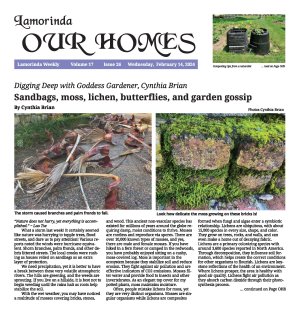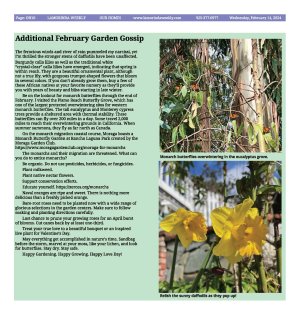|
|
Published February 14th, 2024
|
Digging Deep with Goddess Gardener, Cynthia Brian
|
| Sandbags, moss, lichen, butterflies, and garden gossip |
| By Cynthia Brian |
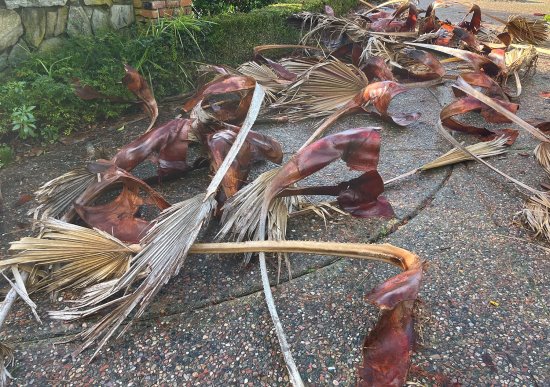 |
| The storm caused branches and palm fronds to fall. Photos Cynthia Brian |
"Nature does not hurry, yet everything is accomplished." ~ Lao Tse
 What a storm last week! It certainly seemed like nature was hurrying to topple trees, flood streets, and dare us to pay attention! Various reports noted the winds were hurricane equivalent. Shorn branches, palm fronds, and other debris littered streets. The local creeks were rushing as houses relied on sandbags as an extra layer of protection.
What a storm last week! It certainly seemed like nature was hurrying to topple trees, flood streets, and dare us to pay attention! Various reports noted the winds were hurricane equivalent. Shorn branches, palm fronds, and other debris littered streets. The local creeks were rushing as houses relied on sandbags as an extra layer of protection.
 We need precipitation, yet it is better to have a break between these very volatile atmospheric rivers. The hills are greening, and the weeds are sprouting. If you live on a hillside, it is best not to begin weeding until the rains halt as roots help stabilize the soil.
We need precipitation, yet it is better to have a break between these very volatile atmospheric rivers. The hills are greening, and the weeds are sprouting. If you live on a hillside, it is best not to begin weeding until the rains halt as roots help stabilize the soil.
 With the wet weather, you may have noticed a multitude of mosses covering bricks, stones, and wood. This ancient non-vascular species has existed for millions of years around the globe requiring damp, moist conditions to thrive. Mosses are rootless and reproduce via spores. There are over 10,000 known types of mosses, and yes, there are male and female mosses. If you have hiked in a fern forest or camped in the redwoods, you have probably enjoyed sitting on a cushy, moss-covered log. Moss is important in the ecosystem because they stabilize soil and reduce erosion. They fight against air pollution and are effective indicators of CO2 emissions. Mosses filter water and provide food to insects and other invertebrates. As an elegant top cover for my potted plants, moss maintains moisture.
With the wet weather, you may have noticed a multitude of mosses covering bricks, stones, and wood. This ancient non-vascular species has existed for millions of years around the globe requiring damp, moist conditions to thrive. Mosses are rootless and reproduce via spores. There are over 10,000 known types of mosses, and yes, there are male and female mosses. If you have hiked in a fern forest or camped in the redwoods, you have probably enjoyed sitting on a cushy, moss-covered log. Moss is important in the ecosystem because they stabilize soil and reduce erosion. They fight against air pollution and are effective indicators of CO2 emissions. Mosses filter water and provide food to insects and other invertebrates. As an elegant top cover for my potted plants, moss maintains moisture.
 Often, people mistake lichens for moss, yet they are very distinct organisms. Mosses are singular organisms while lichens are composites formed when fungi and algae enter a symbiotic relationship. Lichens are ubiquitous, with about 15,000 species in every size, shape, and color. They grow on trees, rocks, and walls, and can even make a home out of decaying fabric. Lichens are a primary colonizing species with around 3,600 species reported in North America. Through decomposition, they influence soil formation, which helps create the correct conditions for other organisms to flourish. Lichens are keystone reflections of the health of an environment. Where lichens prosper, the area is healthy with good air quality. Lichens fight air pollution as they absorb carbon dioxide through their photosynthesis process. Lichens benefit humans by absorbing pollutants, including heavy metals, sulfur, and carbon. Scientists can extract these toxins to determine pollution levels.
Often, people mistake lichens for moss, yet they are very distinct organisms. Mosses are singular organisms while lichens are composites formed when fungi and algae enter a symbiotic relationship. Lichens are ubiquitous, with about 15,000 species in every size, shape, and color. They grow on trees, rocks, and walls, and can even make a home out of decaying fabric. Lichens are a primary colonizing species with around 3,600 species reported in North America. Through decomposition, they influence soil formation, which helps create the correct conditions for other organisms to flourish. Lichens are keystone reflections of the health of an environment. Where lichens prosper, the area is healthy with good air quality. Lichens fight air pollution as they absorb carbon dioxide through their photosynthesis process. Lichens benefit humans by absorbing pollutants, including heavy metals, sulfur, and carbon. Scientists can extract these toxins to determine pollution levels.
 Hummingbirds and other birds make nests from lichens, using them as camouflage and insulation. Many grazing animals include lichens as a nutritious food source. Some insects have adapted their appearance to be disguised as lichen. If you have lichens growing on your rocks, trees, and soil on your property, you are fortunate. This means that the air you are breathing is clean and healthy. Be careful to not disturb lichen-encrusted soil as it can take years to regenerate. When I was visiting Iceland, we were specifically told not to walk or sit on the lichen-covered earth as it could take hundreds of years to re-grow. Nature is not hurrying with lichen. I am eternally grateful for the bounty of lichens that call my landscape home.
Hummingbirds and other birds make nests from lichens, using them as camouflage and insulation. Many grazing animals include lichens as a nutritious food source. Some insects have adapted their appearance to be disguised as lichen. If you have lichens growing on your rocks, trees, and soil on your property, you are fortunate. This means that the air you are breathing is clean and healthy. Be careful to not disturb lichen-encrusted soil as it can take years to regenerate. When I was visiting Iceland, we were specifically told not to walk or sit on the lichen-covered earth as it could take hundreds of years to re-grow. Nature is not hurrying with lichen. I am eternally grateful for the bounty of lichens that call my landscape home.
 Additional February Garden Gossip
Additional February Garden Gossip

 The ferocious winds and river of rain pummeled my narcissi, yet I'm thrilled the stronger stems of daffodils have been unaffected.
The ferocious winds and river of rain pummeled my narcissi, yet I'm thrilled the stronger stems of daffodils have been unaffected.
 Burgundy calla lilies as well as the traditional white "crystal-clear" calla lilies have emerged, indicating that spring is within reach. They are a beautiful ornamental plant, although not a true lily, with gorgeous trumpet-shaped flowers that bloom in several colors. If you don't already grow them, buy a few of these African natives at your favorite nursery as they'll provide you with years of beauty and bliss starting in late winter.
Burgundy calla lilies as well as the traditional white "crystal-clear" calla lilies have emerged, indicating that spring is within reach. They are a beautiful ornamental plant, although not a true lily, with gorgeous trumpet-shaped flowers that bloom in several colors. If you don't already grow them, buy a few of these African natives at your favorite nursery as they'll provide you with years of beauty and bliss starting in late winter.
 Be on the lookout for monarch butterflies through the end of February. I visited the Pismo Beach Butterfly Grove, which has one of the largest protected overwintering sites for western monarch butterflies. The tall eucalyptus and Monterey cypress trees provide a sheltered area with thermal stability. These butterflies can fly over 200 miles in a day. Some travel 2,000 miles to reach their overwintering grounds in California. When summer summons, they fly as far north as Canada.
Be on the lookout for monarch butterflies through the end of February. I visited the Pismo Beach Butterfly Grove, which has one of the largest protected overwintering sites for western monarch butterflies. The tall eucalyptus and Monterey cypress trees provide a sheltered area with thermal stability. These butterflies can fly over 200 miles in a day. Some travel 2,000 miles to reach their overwintering grounds in California. When summer summons, they fly as far north as Canada.
 On the monarch migration coastal course, Moraga boasts a Monarch Butterfly Garden at Rancho Laguna Park created by the Moraga Garden Club.
https://www.moragagardenclub.org/moraga-for-monarchs
On the monarch migration coastal course, Moraga boasts a Monarch Butterfly Garden at Rancho Laguna Park created by the Moraga Garden Club.
https://www.moragagardenclub.org/moraga-for-monarchs
 The monarchs and their migration are threatened. What can you do to entice monarchs?
The monarchs and their migration are threatened. What can you do to entice monarchs?
 Be organic. Do not use pesticides, herbicides, or fungicides.
Be organic. Do not use pesticides, herbicides, or fungicides.
 Plant milkweed.
Plant milkweed.
 Plant native nectar flowers.
Plant native nectar flowers.
 Support conservation efforts.
Support conservation efforts.
 Educate yourself. https://xerces.org/monarchs
Educate yourself. https://xerces.org/monarchs
 Naval oranges are ripe and sweet. There is nothing more delicious than a freshly picked orange.
Naval oranges are ripe and sweet. There is nothing more delicious than a freshly picked orange.
 Bare-root roses need to be planted now with a wide range of glorious selections in the garden centers. Make sure to follow soaking and planting directions carefully.
Bare-root roses need to be planted now with a wide range of glorious selections in the garden centers. Make sure to follow soaking and planting directions carefully.
 Last chance to prune your growing roses for an April burst of blooms. Cut canes back by at least one-third.
Last chance to prune your growing roses for an April burst of blooms. Cut canes back by at least one-third.
 Treat your true love to a beautiful bouquet or an inspired live plant for Valentine's Day.
Treat your true love to a beautiful bouquet or an inspired live plant for Valentine's Day.
 May everything get accomplished in nature's time. Sandbag before the storm, marvel at your moss, like your lichen, and look for butterflies. Stay dry. Stay safe.
May everything get accomplished in nature's time. Sandbag before the storm, marvel at your moss, like your lichen, and look for butterflies. Stay dry. Stay safe.
 Happy Gardening. Happy Growing. Happy Love Day!
Happy Gardening. Happy Growing. Happy Love Day! |
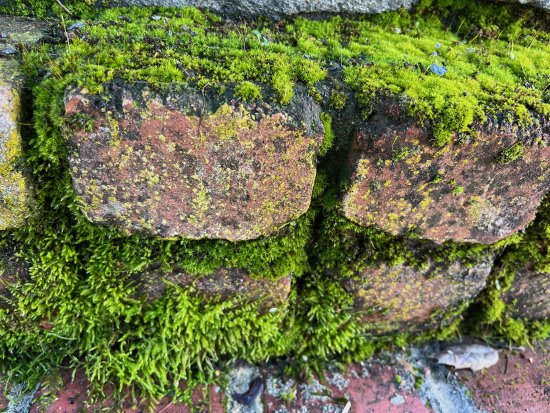 |
| Look how delicate the moss growing on these bricks is! Photos Cynthia Brian |
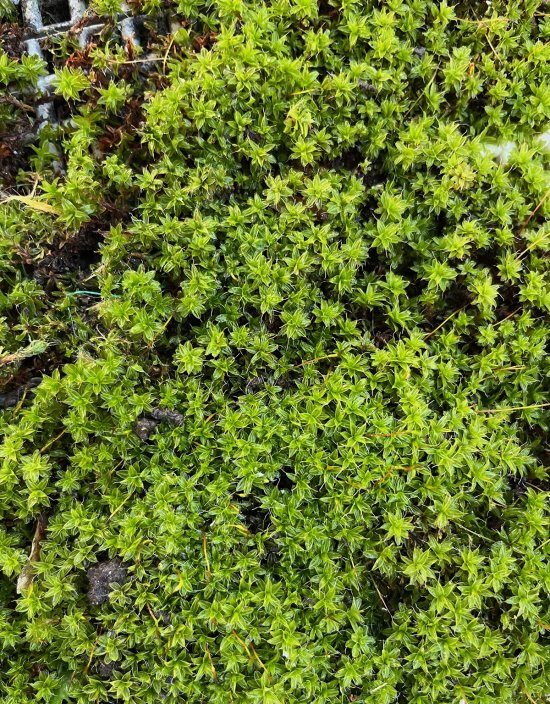 |
| A different species of moss thrives on the pavement. Photos Cynthia Brian |
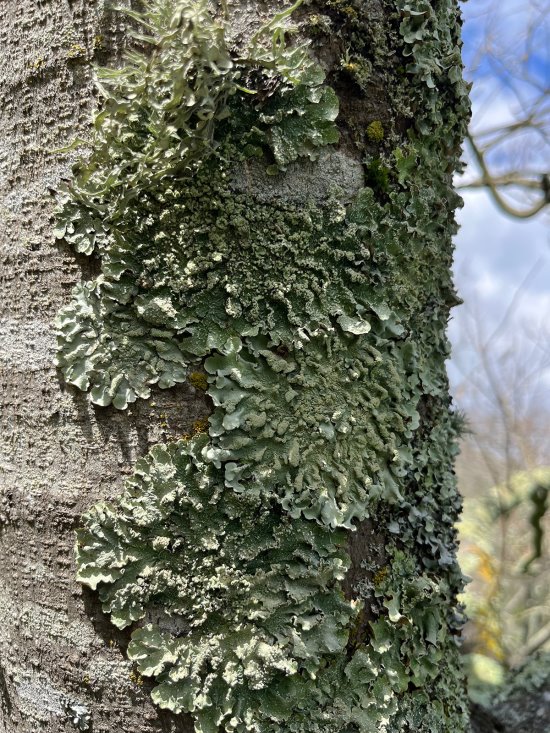 |
| You have a healthy yard when you have lichen growing on your trees. Photos Cynthia Brian |
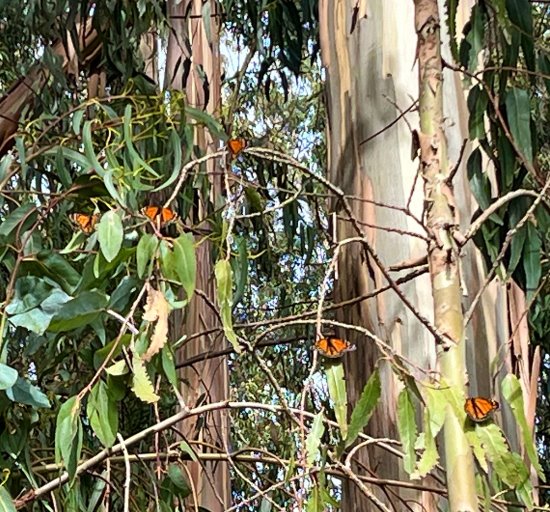 |
| Monarch butterflies overwintering in the eucalyptus grove. Photos Cynthia Brian |
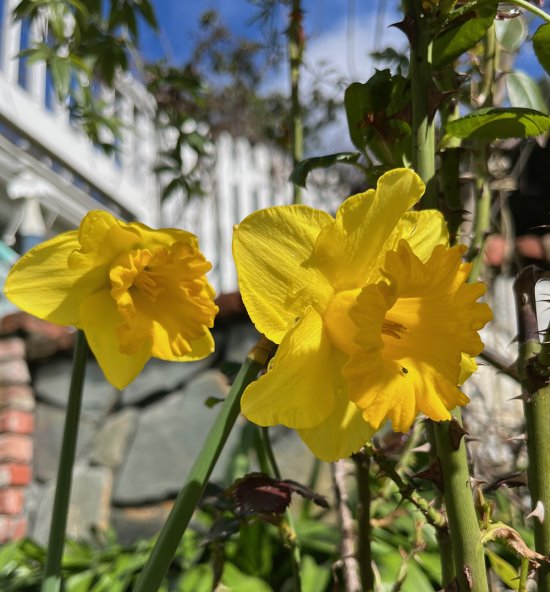 |
| Relish the sunny daffodils as they pop up! |
 |
| |
Purple is the color for February for Cynthia Brian.
For more gardening advice for all seasons, check out Growing with the Goddess Gardener at
https://www.CynthiaBrian.com/books. Raised in the vineyards of Napa County, Cynthia Brian is a New York Times best-selling author, actor, radio personality, speaker, media and writing coach as well as the Founder and Executive Director of Be the Star You Are!r 501 c3. Tune into Cynthia's StarStyler Radio Broadcast at
www.StarStyleRadio.com. Her newest children's picture book, Family Forever, from the series, Stella Bella's Barnyard Adventures is available now at
https://www.CynthiaBrian.com/online-store. Hire Cynthia for writing projects, garden consults, and inspirational lectures.
Cynthia@GoddessGardener.com
https://www.CynthiaBrian.com |
|
|
|








